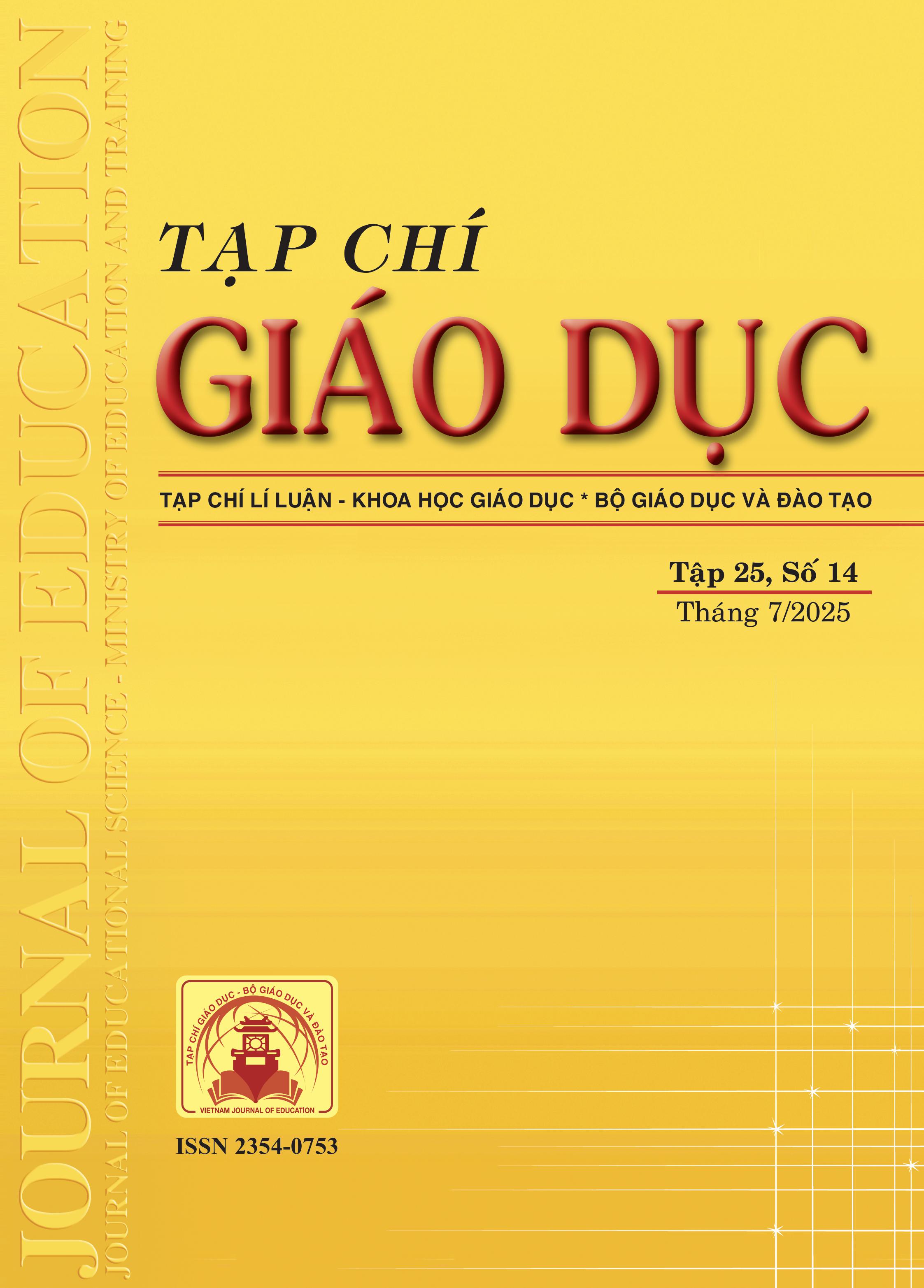Dạy học kết hợp trong giáo dục đại học: Phân tích tổng quan từ góc nhìn quốc tế
- Từ khóa:
- Blended Learning
- higher education
- overview
Tóm tắt
Amid the rapid digital transformation and increasing demand for flexible learning, blended learning has become a prevailing trend in higher education worldwide. Synthesizing existing research on this topic is essential to derive practical lessons for implementing blended learning effectively in Vietnam. This study reviews 26 journal articles, examining key aspects including teaching strategies, learners’ perceptions and satisfaction, benefits of participation, factors influencing learning outcomes, and strategies to enhance the effectiveness of blended learning initiatives. The findings suggest that although blended learning offers significant potential to improve educational outcomes, several challenges persist, notably technological barriers and limited learner interaction. These insights provide a critical foundation for designing teacher training programs and investing in infrastructure to support the successful adoption of blended learning in Vietnam. Furthermore, the study identifies research gaps that warrant further investigation in future studies on this subject.
Tài liệu tham khảo
Ahmad, N. S., Ismail, A., & Husain, Z. (2022). Psychological well-being impacts among university students on online learning during the COVID-19 pandemic. International Journal of Public Health Science, 11(3), 1037-1045. https://doi.org/10.11591/ijphs.v11i3.21413
Ali, R. (2023). Institutional adoption and implementation of blended learning: Differences in student perceptions. Turkish Online Journal of Distance Education, 24(1), 37-53. https://doi.org/10.17718/tojde.973869
Alsalhi, N. R., Eltahir, M., Dawi, E., Abdelkader, A., & Zyoud, S. (2021). The effect of blended learning on the achievement in a physics course of students of a dentistry college: A case study at Ajman University. Electronic Journal of e-Learning, 19(1), 1-17. https://doi.org/10.34190/ejel.19.1.1992
Armellini, A., Teixeira Antunes, V., & Howe, R. (2021). Student perspectives on learning experiences in a higher education active blended learning context. TechTrends, 65(4), 433-443. https://doi.org/10.1007/s11528-021-00593-w
Canales-Ronda, P., & Aragonés-Jericó, C. (2022). Agile methodologies in times of pandemic: Acquisition of employment skills in higher education. Education + Training, 64(6), 811-825. https://doi.org/10.1108/ET-12-2021-0445
Cedillo-Hernandez, A., & Velazquez-Garcia, L. (2022). Impact of the b-Learning model on university teaching. International Journal of Information and Education Technology, 12(5), 378-383. https://doi.org/10.18178/ijiet.2022.12.5.1630
Chen, X., & Wang, Y. (2024). The impact of blended learning environment on learning effectiveness: Exploring the role of behavioral intention and self-efficacy via UTAUT2. SAGE Open. https://doi.org/10.1177/21582440241251604
Green, Z. A., & Rizwan, S. (2023). Art-of-living intervention imparted through a blended learning approach to nurture positivity among Pakistan’s university students during COVID-19: A growth curve analysis. Journal of Happiness Studies, 24(6), 1931-1962. https://doi.org/10.1007/s10902-023-00664-0
Hasan, K. K., Mukherjee, D., & Saha, M. (2021). Learning continuity during COVID-19 pandemic using the virtual classroom—a cross-border experimental multi-case approach. Journal of Education Culture and Society, 12(1), 335-345. https://doi.org/10.15503/jecs2021.1.335.345
Huang, M., Kuang, F., & Ling, Y. (2022). EFL learners’ engagement in different activities of blended learning environment. Asian-Pacific Journal of Second and Foreign Language Education, 7(1). https://doi.org/10.1186/s40862-022-00136-7
Huang, Q., & Lee, V. W. Y. (2022). Exploring first-year university students’ blended learning experiences during the COVID-19 through the community of inquiry model. International Journal of Information and Learning Technology, 39(4), 373-385. https://doi.org/10.1108/IJILT-02-2022-0024
Kemp, N. (2020). University students’ perceived effort and learning in face-to-face and online classes. Journal of Applied Learning and Teaching, 3(Special Issue 1), 69-77. https://doi.org/10.37074/jalt.2020.3.s1.14
Kusi, H., & Boateng, R. (2024). Challenges of blended learning in Global North and South higher education: A systematic and integrative review. Social Sciences & Humanities Open. https://www.sciencedirect.com/science/article/pii/S2590291124002080
Lo, K. H. (2024). Effective student engagement in blended learning: A systematic review. Heliyon. https://www.sciencedirect.com/science/article/pii/S2405844024154709
Ma, J., Li, C., & Liang, H.-N. (2019). Enhancing students’ blended learning experience through embedding metaliteracy. Education Research International, 2019. https://doi.org/10.1155/2019/6791058
Navío-Marco, J., Sánchez-Figueroa, C., & Galán, A. (2023). Business internships for bachelor’s degrees at blended learning universities: A pilot study to assess the transition from hybrid studies to the workplace. International Journal of Management Education, 21(2). https://doi.org/10.1016/j.ijme.2023.100821
Nguyen, T. L., & Do, V. T. (2024). A meta-analysis of online learning's impact on academic achievement in higher education during COVID-19. Interactive Learning Environments. https://doi.org/10.1080/10494820.2024.2375347
Nikou, S., & Maslov, I. (2023). Finnish university students’ satisfaction with e-learning outcomes during the COVID-19 pandemic. International Journal of Educational Management, 37(1), 1-21. https://doi.org/10.1108/IJEM-04-2022-0166
Nikolopoulou, K., & Zacharis, G. (2023). Blended learning in a higher education context: Exploring university students’ learning behavior. Education Sciences, 13(5). https://doi.org/10.3390/educsci13050514
Tran, H. T., & Le, M. T. (2024). The impact of online learning on student performance and engagement: A systematic review. Discover Education. https://doi.org/10.1007/s44217-024-00253-0
Turu, M., van Rossum, T., & Gridley, N. (2023). Starting university during the COVID-19 pandemic: A small-scale study of first-year education students’ expectations, experiences and preferences. Learning and Teaching, 16(1), 77-97. https://doi.org/10.3167/latiss.2023.160105
Wang, X., Chen, X., Wu, X., Lu, J., Xu, B., & Wang, H. (2023). Research on the influencing factors of university students’ learning ability satisfaction under the blended learning model. Sustainability, 15(16). https://doi.org/10.3390/su151612454
Yang, X., Zhou, X., & Hu, J. (2022). Students’ preferences for seating arrangements and their engagement in cooperative learning activities in college English blended learning classrooms in higher education. Higher Education Research & Development, 41(4), 1356-1371. https://doi.org/10.1080/07294360.2021.1901667
Yang, Y.-F., & Kuo, N.-C. (2023). Blended learning to foster EFL college students’ global literacy. Computer Assisted Language Learning, 36(1-2), 81-102. https://doi.org/10.1080/09588221.2021.1900874
Yu, T., Dai, J., & Wang, C. (2023). Adoption of blended learning: Chinese university students’ perspectives. Humanities and Social Sciences Communications, 10(1). https://doi.org/10.1057/s41599-023-01904-7
Zhang, Z., Cao, T., Shu, J., & Liu, H. (2022). Identifying key factors affecting college students’ adoption of the elearning system in mandatory blended learning environments. Interactive Learning Environments, 30(8), 1388-1401. https://doi.org/10.1080/10494820.2020.1723113
Tải xuống
Đã Xuất bản
Cách trích dẫn
Số
Chuyên mục
Giấy phép

Tác phẩm này được cấp phép theo Ghi nhận tác giả của Creative Commons Giấy phép quốc tế 4.0 .












